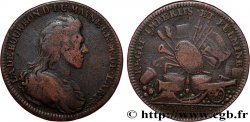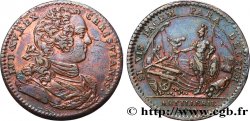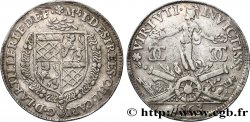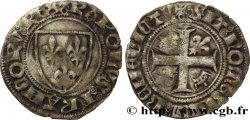fjt_011103 - ARTILLERY Louis-Charles de Bourbon, comte d’Eu - EUROPA 1749
Not available.
Item sold on our e-shop (2009)
Price : 135.00 €
Item sold on our e-shop (2009)
Price : 135.00 €
Type : Louis-Charles de Bourbon, comte d’Eu - EUROPA
Date: 1749
Metal : silver
Diameter : 29 mm
Orientation dies : 6 h.
Edge : cannelée
Rarity : R3
Obverse
Obverse legend : LOUIS CH. DE BOURBON C. D'EU DUC D'AUM. G. M. DE L'ART.
Obverse description : Buste drapé à droite de Louis-Charles de Bourbon-Eu sans signature.
Reverse
Reverse legend : MUTAT JOVIS ALES FULMEN OLIVA ; À L'EXERGUE : ARTILLERIE.1749.
Reverse description : Aigle éployé dans les airs, portant une branche d'olivier dans ses serres. Dessous, une partie de globe avec l'inscription : EUROPA.
Reverse translation : L'oiseau de Zeus échange la foudre contre un rameau d'olivier.
Commentary
Frappe sur flan poli d'une qualité exceptionnelle. Il s'agit certainement d'une frappe de présentation, ce qui explique le R3, le type en lui-même , n’étant pas rare. La frappe est indiscutablement d’époque.
Louis-Charles de Bourbon, comte d’Eu, est le second fils de Louis-Auguste de Bourbon, duc du Maine et fils légitimé de Louis XIV et de Madame de Montespan. Très aimé de son père, le duc du Maine reçut rang immédiatement après les princes du sang et fut nommé grand maître de l’artillerie. Il obtint aussi les principautés d’Aumale et de Dombes. Louis-Charles, déjà comte d’Eu, reçut l’héritage de son frère aîné, Louis-Auguste, tué en duel en 1755
Anne-Marie-Louis d'Orléans, connue sous le nom de la "Grande Mademoiselle"mourut en 1693, laissant la principauté de Dombes à Louis Auguste de Bourbon, duc du Maine, fils de Louis XIV légitimé en 1673. Louis Charles de Bourbon, comte d'Eu, échangea le 28 mars 1762 la principauté de Dombes contre le duché de Gisors.
Strike on polished flan of exceptional quality. This is certainly a presentation strike, which explains the R3, the type itself, not being rare. The strike is indisputably of the period. Louis-Charles de Bourbon, Count of Eu, is the second son of Louis-Auguste de Bourbon, Duke of Maine and legitimized son of Louis XIV and Madame de Montespan. Much loved by his father, the Duke of Maine received rank immediately after the princes of the blood and was named Grand Master of the Artillery. He also obtained the principalities of Aumale and Dombes. Louis-Charles, already Count of Eu, received the inheritance of his elder brother, Louis-Auguste, killed in a duel in 1755 Anne-Marie-Louis d'Orléans, known as the \\\"Grande Mademoiselle\\\" died in 1693, leaving the principality of Dombes to Louis Auguste de Bourbon, Duke of Maine, son of Louis XIV legitimized in 1673. Louis Charles de Bourbon, Count of Eu, exchanged the principality of Dombes for the Duchy of Gisors on March 28, 1762
Louis-Charles de Bourbon, comte d’Eu, est le second fils de Louis-Auguste de Bourbon, duc du Maine et fils légitimé de Louis XIV et de Madame de Montespan. Très aimé de son père, le duc du Maine reçut rang immédiatement après les princes du sang et fut nommé grand maître de l’artillerie. Il obtint aussi les principautés d’Aumale et de Dombes. Louis-Charles, déjà comte d’Eu, reçut l’héritage de son frère aîné, Louis-Auguste, tué en duel en 1755
Anne-Marie-Louis d'Orléans, connue sous le nom de la "Grande Mademoiselle"mourut en 1693, laissant la principauté de Dombes à Louis Auguste de Bourbon, duc du Maine, fils de Louis XIV légitimé en 1673. Louis Charles de Bourbon, comte d'Eu, échangea le 28 mars 1762 la principauté de Dombes contre le duché de Gisors.
Strike on polished flan of exceptional quality. This is certainly a presentation strike, which explains the R3, the type itself, not being rare. The strike is indisputably of the period. Louis-Charles de Bourbon, Count of Eu, is the second son of Louis-Auguste de Bourbon, Duke of Maine and legitimized son of Louis XIV and Madame de Montespan. Much loved by his father, the Duke of Maine received rank immediately after the princes of the blood and was named Grand Master of the Artillery. He also obtained the principalities of Aumale and Dombes. Louis-Charles, already Count of Eu, received the inheritance of his elder brother, Louis-Auguste, killed in a duel in 1755 Anne-Marie-Louis d'Orléans, known as the \\\"Grande Mademoiselle\\\" died in 1693, leaving the principality of Dombes to Louis Auguste de Bourbon, Duke of Maine, son of Louis XIV legitimized in 1673. Louis Charles de Bourbon, Count of Eu, exchanged the principality of Dombes for the Duchy of Gisors on March 28, 1762








 Report a mistake
Report a mistake Print the page
Print the page Share my selection
Share my selection Ask a question
Ask a question Consign / sell
Consign / sell
 Full data
Full data











